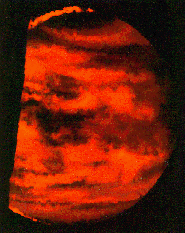
Note: Click on Solar System Exploration: Galileo Legacy Site (NASA-JPL) to get this image at its highest resolution.
False-color infrared image of low clouds on Venus' night side, taken on
February 10, 1990.
Range 96,600 kilometers (60,000 miles) above the planet.
Venus is shrouded in thick sulfuric acid clouds many kilometers thick, so using a standard camera in visible light to take pictures of the planet results in a bland-looking ball. In this image, Galileo used its Near Infrared Mapping Spectrometer (NIMS) as the spacecraft approached the planet's night side. Bright slivers of sunlit high clouds are visible on the limb (or planet "edges") at top and bottom. The image was constructed using an infrared wavelength of 2.3 microns (90 millionths of an inch), which is about three times longer than the longest wavelength of light visible to the human eye.
The map shows the turbulent, cloudy middle atmosphere some 50 to 55 kilometers (30 to 34 miles) above the Venusian surface; these clouds are 10 to 16 kilometers (6 to 10 miles) below the visible cloud tops. The red color represents the radiant heat from the lower atmosphere (about 400 degrees Fahrenheit) shining through the sulfuric acid clouds, which appear as much as 10 times darker than the bright gaps between clouds. This cloud layer is about -30 degrees Fahrenheit, at a pressure about one half Earth's surface atmospheric pressure.
Near the equator, the clouds appear fluffy and blocky; further north, they are stretched out into east-west filaments by winds estimated at more than 70 meters per second (150 miles per hour). At this height above the surface, the poles are capped by thick clouds.
False color can also be used to enhance detail in regular pictures where there isn't a wide range of color - for example, in an aerial photo of a jungle, which may appear as a carpet of unbroken green. By assigning slightly different shades of visible green to radically different false colors like red and blue, scientists can make detail stand out. Or, the faint colors of a planetary picture can be boosted brighter, making it easier to pick out geological features. Such image processing techniniques are also used in areas such as CAT scans.
Next slide: Venus
Back to: Galileo To Jupiter
Link to: Solar System Exploration: Galileo Legacy Site (NASA - JPL)
Updated: July 23 '96
Best seen with MS Internet Explorer.
Back: ARVAL - Image Gallery
Messages: